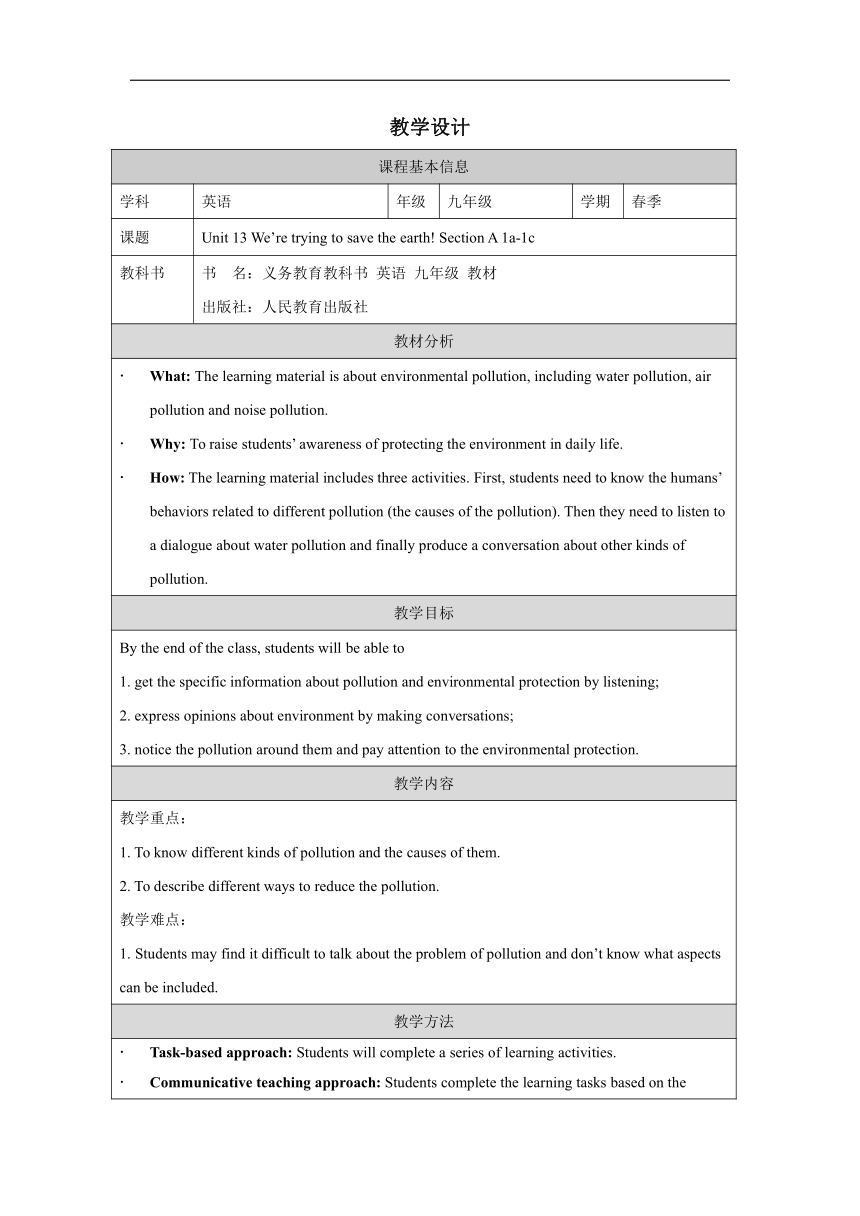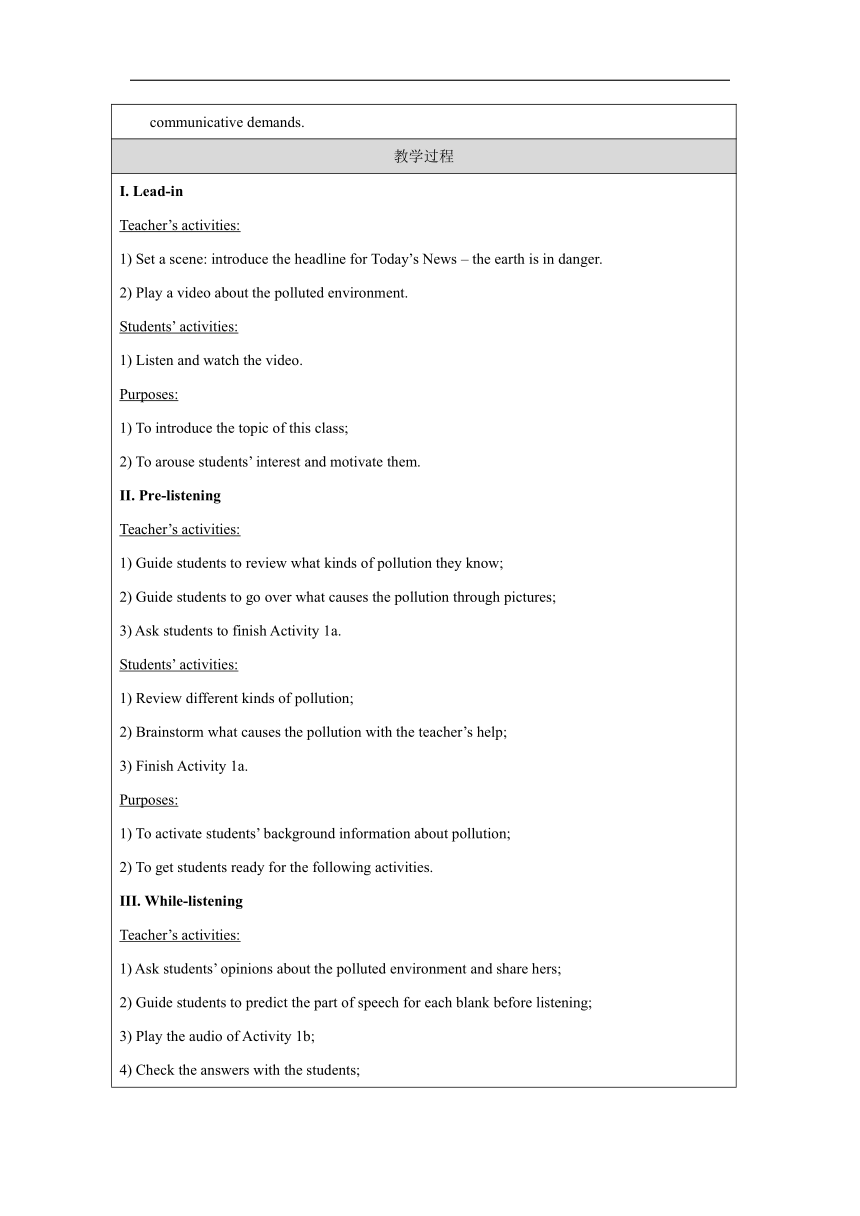Unit 13 We’re trying to save the earth! Section A 1a~1c表格式教学设计
文档属性
| 名称 | Unit 13 We’re trying to save the earth! Section A 1a~1c表格式教学设计 |  | |
| 格式 | docx | ||
| 文件大小 | 25.5KB | ||
| 资源类型 | 教案 | ||
| 版本资源 | 人教新目标(Go for it)版 | ||
| 科目 | 英语 | ||
| 更新时间 | 2024-08-28 17:46:34 | ||
图片预览


文档简介
教学设计
课程基本信息
学科 英语 年级 九年级 学期 春季
课题 Unit 13 We’re trying to save the earth! Section A 1a-1c
教科书 书 名:义务教育教科书 英语 九年级 教材 出版社:人民教育出版社
教材分析
What: The learning material is about environmental pollution, including water pollution, air pollution and noise pollution. Why: To raise students’ awareness of protecting the environment in daily life. How: The learning material includes three activities. First, students need to know the humans’ behaviors related to different pollution (the causes of the pollution). Then they need to listen to a dialogue about water pollution and finally produce a conversation about other kinds of pollution.
教学目标
By the end of the class, students will be able to 1. get the specific information about pollution and environmental protection by listening; 2. express opinions about environment by making conversations; 3. notice the pollution around them and pay attention to the environmental protection.
教学内容
教学重点: 1. To know different kinds of pollution and the causes of them.
2. To describe different ways to reduce the pollution.
教学难点: 1. Students may find it difficult to talk about the problem of pollution and don’t know what aspects can be included.
教学方法
Task-based approach: Students will complete a series of learning municative teaching approach: Students complete the learning tasks based on the communicative demands.
教学过程
I. Lead-in Teacher’s activities: 1) Set a scene: introduce the headline for Today’s News – the earth is in danger. 2) Play a video about the polluted environment. Students’ activities: 1) Listen and watch the video. Purposes: 1) To introduce the topic of this class; 2) To arouse students’ interest and motivate them. II. Pre-listening Teacher’s activities: 1) Guide students to review what kinds of pollution they know; 2) Guide students to go over what causes the pollution through pictures; 3) Ask students to finish Activity 1a. Students’ activities: 1) Review different kinds of pollution; 2) Brainstorm what causes the pollution with the teacher’s help; 3) Finish Activity 1a. Purposes: 1) To activate students’ background information about pollution; 2) To get students ready for the following activities. III. While-listening Teacher’s activities: 1) Ask students’ opinions about the polluted environment and share hers; 2) Guide students to predict the part of speech for each blank before listening; 3) Play the audio of Activity 1b; 4) Check the answers with the students; 5) Summarize the structure of the dialogue. Students’ activities: 1) Tell their opinions about the polluted environment; 2) Predict the part of speech for each blank before listening; 3) Listen to the audio of Activity 1b; 4) Check the answers; 5) Get to know the structure of the dialogue. Purposes: 1) To practice the listening skill – prediction; 2) To enhance the logical thinking by analyzing the structure; 3) To get the structure ready for the following activities. IV. Post-listening Teacher’s activities: 1) Lead to a conversation between two students talking about environmental pollution; 2) Point out the four aspects (the problem, reasons, how it used to be, things to help) when talking about pollution; 3) Guide students to go over the four aspects of the three kinds of pollution. Students’ activities: 1) Listen to the conversation between two students talking about environmental pollution; 2) Get to know the four aspects (the problem, reasons, how it used to be, things to help) when talking about pollution; 3) Go over the four aspects of the three kinds of pollution; 4) Make conversations according to the tips. Purposes: 1) To consolidate what students have learnt. V. Summary & Homework Teacher’s activities: 1) Introduce the self-assessment table; 2) Assign homework. Students’ activities: 1) Check their achievement for the class according to the assessment table; 2) Get to know the homework. Purposes: 1) To consolidate.
备注:教学设计应至少含教学目标、教学内容、教学过程等三个部分,如有其它内容,可自行补充增加。
课程基本信息
学科 英语 年级 九年级 学期 春季
课题 Unit 13 We’re trying to save the earth! Section A 1a-1c
教科书 书 名:义务教育教科书 英语 九年级 教材 出版社:人民教育出版社
教材分析
What: The learning material is about environmental pollution, including water pollution, air pollution and noise pollution. Why: To raise students’ awareness of protecting the environment in daily life. How: The learning material includes three activities. First, students need to know the humans’ behaviors related to different pollution (the causes of the pollution). Then they need to listen to a dialogue about water pollution and finally produce a conversation about other kinds of pollution.
教学目标
By the end of the class, students will be able to 1. get the specific information about pollution and environmental protection by listening; 2. express opinions about environment by making conversations; 3. notice the pollution around them and pay attention to the environmental protection.
教学内容
教学重点: 1. To know different kinds of pollution and the causes of them.
2. To describe different ways to reduce the pollution.
教学难点: 1. Students may find it difficult to talk about the problem of pollution and don’t know what aspects can be included.
教学方法
Task-based approach: Students will complete a series of learning municative teaching approach: Students complete the learning tasks based on the communicative demands.
教学过程
I. Lead-in Teacher’s activities: 1) Set a scene: introduce the headline for Today’s News – the earth is in danger. 2) Play a video about the polluted environment. Students’ activities: 1) Listen and watch the video. Purposes: 1) To introduce the topic of this class; 2) To arouse students’ interest and motivate them. II. Pre-listening Teacher’s activities: 1) Guide students to review what kinds of pollution they know; 2) Guide students to go over what causes the pollution through pictures; 3) Ask students to finish Activity 1a. Students’ activities: 1) Review different kinds of pollution; 2) Brainstorm what causes the pollution with the teacher’s help; 3) Finish Activity 1a. Purposes: 1) To activate students’ background information about pollution; 2) To get students ready for the following activities. III. While-listening Teacher’s activities: 1) Ask students’ opinions about the polluted environment and share hers; 2) Guide students to predict the part of speech for each blank before listening; 3) Play the audio of Activity 1b; 4) Check the answers with the students; 5) Summarize the structure of the dialogue. Students’ activities: 1) Tell their opinions about the polluted environment; 2) Predict the part of speech for each blank before listening; 3) Listen to the audio of Activity 1b; 4) Check the answers; 5) Get to know the structure of the dialogue. Purposes: 1) To practice the listening skill – prediction; 2) To enhance the logical thinking by analyzing the structure; 3) To get the structure ready for the following activities. IV. Post-listening Teacher’s activities: 1) Lead to a conversation between two students talking about environmental pollution; 2) Point out the four aspects (the problem, reasons, how it used to be, things to help) when talking about pollution; 3) Guide students to go over the four aspects of the three kinds of pollution. Students’ activities: 1) Listen to the conversation between two students talking about environmental pollution; 2) Get to know the four aspects (the problem, reasons, how it used to be, things to help) when talking about pollution; 3) Go over the four aspects of the three kinds of pollution; 4) Make conversations according to the tips. Purposes: 1) To consolidate what students have learnt. V. Summary & Homework Teacher’s activities: 1) Introduce the self-assessment table; 2) Assign homework. Students’ activities: 1) Check their achievement for the class according to the assessment table; 2) Get to know the homework. Purposes: 1) To consolidate.
备注:教学设计应至少含教学目标、教学内容、教学过程等三个部分,如有其它内容,可自行补充增加。
同课章节目录
- Unit 1 How can we become good learners.
- Section A
- Section B
- Unit 2 I think that mooncakes are delicious!
- Section A
- Section B
- Unit 3 Could you please tell me where the restroom
- Section A
- Section B
- Unit 4 I used to be afraid of the dark.
- Section A
- Section B
- Unit 5 What are the shirts made of?
- Section A
- Section B
- Review of Units 1-5
- Unit 6 When was it invented?
- Section A
- Section B
- Unit 7 Teenagers should be allowed to choose their
- Section A
- Section B
- Unit 8 It must belong to Carla.
- Section A
- Section B
- Unit 9 I like music that I can dance to.
- Section A
- Section B
- Unit 10 You're supposed to shake hands.
- Section A
- Section B
- Review of Units 6-10
- Unit 11 Sad movies make me cry.
- Section A
- Section B
- Unit 12 Life is full of the unexpected
- Section A
- Section B
- Unit 13 We're trying to save the earth!
- Section A
- Section B
- Unit 14 I remember meeting all of you in Grade 7.
- Section A
- Section B
- Review of Units 11-14
